|
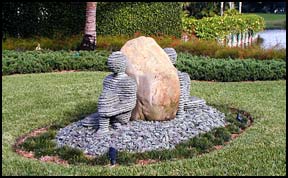 Boaz Vaadia is the internationally known sculptor whose timeless, evocative stone figures now inhabit Florida's cultural sites, art galleries and private collections. As major installations at prime buildings, parks and homes around the world, they set a tone of peace and serenity in our increasingly conflicted world. Boaz Vaadia is the internationally known sculptor whose timeless, evocative stone figures now inhabit Florida's cultural sites, art galleries and private collections. As major installations at prime buildings, parks and homes around the world, they set a tone of peace and serenity in our increasingly conflicted world.
Born and raised in Israel, Vaadia moved to New York City in 1975 thanks to a grant he received from the American-Israel Cultural Foundation.
Vaadia established his studio in SoHo just before its streets labored to give birth to a new community of working artists. Roads were torn up and buildings were torn down. In the chaos of New York City, he discovered supplies from the earth. Slate and bluestone, ubiquitous materials of the city are sedimentary rocks from glacial periods, millions of years old. The city's detritus: vestigial windowsills, shingles and curb stones were all readily available to an artist, permitting the recycling of nature's resources to build, destruct and reconstruct edifices of the future. Vaadia used these materials to make personal totems that evoked primal energies and ritual.
Vaadia says: "I work with the stone as if I were another force of nature. By carving the stone, I release its inherent energies. This stone sculpture now carries a direct message to the soul of the viewer. Man came from the earth and in death returns to it. I see stone as the bone structure of the earth....the life span of the stone is millions of years, whereas our life span is just a speck in relation to the time of the stone."
Starting in 1985, generic representations of man and woman emerged from Vaadia's earlier abstract, monumental effigies. Though generalized in form, there is some individuality in each figure, the artist's intention being to represent the essence of a specific person. "I love people. Each person is unique, as is the work of an artist. It is important that we, as artists, identify our own uniqueness, just as every individual needs to identify his/her own individuality." This individuality resides in centeredness, not in superficial attributes. It is that which unites us as human beings.
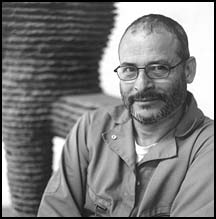 Initially, sculptures were of a single person, then two people. A dog becomes a frequent, integral element. Family groupings appear with homage to Henry Moore. At times a pillar suggesting home and shelter completes the composition. Gender indicators tend to be minimal; they are less important than the relationships. Attitudes of the figures are formal. Their frontality and direct gaze link them with totems, ancient Egyptian and Pre-Columbian statues. Figures as they relate to each other and to the earth are always grounded, serene, present and eternal. Viewers are encouraged to imagine and personalize the generalized aspects and to project their own vision and experience onto the work. Initially, sculptures were of a single person, then two people. A dog becomes a frequent, integral element. Family groupings appear with homage to Henry Moore. At times a pillar suggesting home and shelter completes the composition. Gender indicators tend to be minimal; they are less important than the relationships. Attitudes of the figures are formal. Their frontality and direct gaze link them with totems, ancient Egyptian and Pre-Columbian statues. Figures as they relate to each other and to the earth are always grounded, serene, present and eternal. Viewers are encouraged to imagine and personalize the generalized aspects and to project their own vision and experience onto the work.
Vaadia hand carves slices of slate and bluestone, shaping them to be layers in a kind of topographical map. He stacks the horizontal slabs until the graded silhouette of a person, animal or group emerges. Sometimes he places a long single stone piece across a layer within juxtaposed figures to unite them. This subtle strategy suggests the merging and love shared between the figures. He views the geological layering of the stone as a natural model for his own sculptural process. It seems a logical metaphor for our human layering of experience and memory.
In working with the stone, Vaadia respects it for its possibilities and its limitations. As he builds a piece, he is very concerned that it be perfectly balanced and in harmony with the earth before he inserts threaded rods and glue. He is concerned as well about gravity and a sense of the work's gravitational attachment to the earth.
Huge boulders appear as seat supports or background elements in the compositions. Vaadia does little to alter the natural contours of the boulders other than leveling the bottoms and occasionally making a groove to accommodate the figure. He prefers them "as they are, a wonderful counterfoil for the figures."
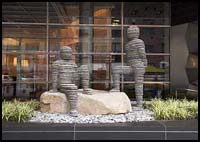 The original inspiration for these boulders is a story typical of Vaadia's "living in the moment." He had moved his studio from SoHo to Brooklyn. The streets there were also being torn up. Ancient boulders were found in excavations right in front of his door and within a three-block radius of his studio. He tells how, as a newcomer, he was riding his bike in the area when he saw boulders in street cavities. Excited, he commented to the workmen about how wondrous these ancient stones were and asked about obtaining some. "If you want them, they're yours; you just have to get them out of here." Bicycling back to his studio, he saw a store advertising a used forklift for $3000. He bought it on the spot and returned for the boulders. He has been retrieving these giant stones ever since. The original inspiration for these boulders is a story typical of Vaadia's "living in the moment." He had moved his studio from SoHo to Brooklyn. The streets there were also being torn up. Ancient boulders were found in excavations right in front of his door and within a three-block radius of his studio. He tells how, as a newcomer, he was riding his bike in the area when he saw boulders in street cavities. Excited, he commented to the workmen about how wondrous these ancient stones were and asked about obtaining some. "If you want them, they're yours; you just have to get them out of here." Bicycling back to his studio, he saw a store advertising a used forklift for $3000. He bought it on the spot and returned for the boulders. He has been retrieving these giant stones ever since.
On the day he moved his studio contents to Brooklyn, it was raining outside. Vaadia invited the moving men inside for their lunch break. The space was already half-filled with boulders. The men walked around looking at these great stones and each seemed to select a particular stone to stand near or to sit upon. Vaadia was fascinated; each person seemed to relate on a very personal level to a particular boulder. It reminded him of how people walk along a beach and are spontaneously attracted to particular stones or shells. After taking these home, the mind "kicks in" and asks, "What do we need them for?" But at the moment the objects are first discovered, something magical happenssome interaction between the stone and the person, a communication, a "calling to" It is the same way viewers are attracted for some personal reason to specific pieces of art.
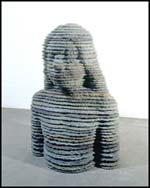 Vaadia's new work focuses on gigantic, layered stone heads, heads that develop from small studies of particular people. He selects all the sitters, beginning with his own children, Sarah and Rebecca, and then seeks other unique heads among people with whom he works and sees on the street. Vaadia takes photos to formalize a first impression, and then sculpts a likeness in oil-based clay, adding grooves to simulate stone layers. The subsequent plaster cast begins to dissolve details, focusing instead on mass, volume and body language, qualities that are characteristic of the sitter. Details are blurred, made more generic in the handling of the stone layers. Vaadia listens to viewers' impressions, enjoying their process of filling in the details and projecting their own interpretation onto the work. Vaadia's new work focuses on gigantic, layered stone heads, heads that develop from small studies of particular people. He selects all the sitters, beginning with his own children, Sarah and Rebecca, and then seeks other unique heads among people with whom he works and sees on the street. Vaadia takes photos to formalize a first impression, and then sculpts a likeness in oil-based clay, adding grooves to simulate stone layers. The subsequent plaster cast begins to dissolve details, focusing instead on mass, volume and body language, qualities that are characteristic of the sitter. Details are blurred, made more generic in the handling of the stone layers. Vaadia listens to viewers' impressions, enjoying their process of filling in the details and projecting their own interpretation onto the work.
In recent years, Vaadia has been making bronze castings of many of the large "outdoor" pieces as well as the variously scaled studies. Practically all of his pieces have been sold. Of the few saleable works left in the studio, all are currently "on hold" for clients. Apart from these, Vaadia is keeping a collection of castings, one from each edition, and a few of the original stone works, for loan to public museums and for exhibitions that travel. In the spring of 2005, two large pieces will be on loan for two years to the DeCordova Museum and Sculpture Park in Lincoln, Massachusetts.
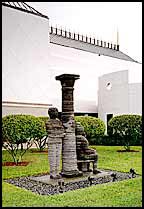 The Philharmonic Center for the Arts, Naples, Florida, boasts the piece Meshullemet and Menashshe, and Asaf and Yo'ah is installed at the south entrance to the Time Warner Center condominium tower at Columbus Circle in New York City. The Philharmonic Center for the Arts, Naples, Florida, boasts the piece Meshullemet and Menashshe, and Asaf and Yo'ah is installed at the south entrance to the Time Warner Center condominium tower at Columbus Circle in New York City.
Zur With Dog was selected from the collection of The Norton Museum of Art in West Palm Beach, Florida, to represent Florida in the 1995 exhibition of 20th Century American Sculpture in the White House Garden, Washington, D.C. The work for this show was selected from museums in the Southeast.
To view Vaadia's studio and many of his pieces and installations, go to his comprehensive web site, http://www.vaadia.com
Drawing inspiration and materials from the ancient, Vaadia sees his work as a continuum from ancient times to the future. Often asked if he uses computers in plotting layers, he explains that he doesn't use them now, but certainly may later on. His goal is to make contemporary art that vibrates with a sense of timelessness in complete harmony with the earth and the human heart. Boaz Vaadia says: "The earth is our Mother; it is the source of everything we need. Sadly, we are polluting itArt is necessary for the soul; it's one of the necessities of life. We need food to sustain us. Without food, after days, weeks, we will die; without water we will die after a few days; and without air, we die after a few minutes. Without art, (true art, connected from the heart), the soul dies almost immediately. Art is intrinsic to our living as human beings."
-Adrienne Garnett is an artist and educator in New York.
|